Mobile Corner
Build Interactive Tiles for Microsoft Band
Now that you know how to communicate with the Band apps, here's another twist. Let's get interactive.
- By Nick Randolph
- 05/12/2016
As a fitness device, the Microsoft Band has a large variety of sensors of which application developers can take advantage. However, the interface on the Band is limited to a series of tiles that display data and accept input from the user.
Last time, I showed how to communicate with the Band. This time we'll get interactive and I'll walk through creating an application that periodically displays a joke on the Band. This will demonstrate not only how to display content on the Band, but also how to accept input back from the user, even if the Windows application isn't running. At the time of writing, Windows 10 Mobile is the only platform where user input can be accepted while the application running on the phone is in the background.
The Band itself doesn't support running third-party applications; instead, it works in conjunction with an application running on the paired mobile device. As such, I'll get started by creating a new project, called JokeMachine, based on the Blank App (Universal Windows Platform [UWP]) template in the New Project dialog, as shown in Figure 1.
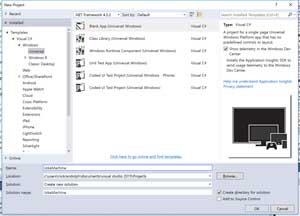 [Click on image for larger view.]
Figure 1. New Universal Windows Platform Application
[Click on image for larger view.]
Figure 1. New Universal Windows Platform Application
The purpose of this application is to display a new "Band Joke" to the user on the Band periodically. The Windows application will be responsible for periodically running as a background task, selecting a joke, and displaying a notification on the Band containing the joke. In addition, there will be a tile on the band that can be used to start and stop the notification of jokes. This relies on the background task of the Windows application being invoked when the user taps on a button on a page associated with the tile.
While a UWP app could manually establish a Bluetooth connection with the Band, Microsoft has already done a lot of the hard work and has provided a nice wrapper library for working with the Band. To access this library, open up the NuGet package manager interface within Visual Studio by right-clicking on the Solution and selecting Manage NuGet Packages for Solution (see Figure 2).
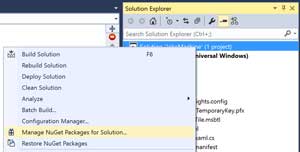 [Click on image for larger view.]
Figure 2. Opening NuGet Package Manager
[Click on image for larger view.]
Figure 2. Opening NuGet Package Manager
Making sure I have the Browse tab selected, I enter Band into the search box, which results in a number of results, the first of which is the Microsoft.Band SDK, produced by Microsoft (Figure 3).
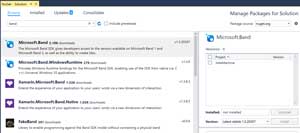 [Click on image for larger view.]
Figure 3. Adding Microsoft.Band NuGet Package
[Click on image for larger view.]
Figure 3. Adding Microsoft.Band NuGet Package
There are only a couple of UI elements on the Band with which a developer can work. Tiles, as the name indicates, are the tiles that appear on the main strip of the Band. When a user taps on a tile, they're shown one or more pages that make up the tile. In order to draw attention to changing content, a tile can display a notification in the form of either a dialog (which disappears when dismissed by the user) or a message (which is added as a page within the tile).
I'll start by creating a tile for my application, but rather than creating the layout manually in code, I'm going to use the Microsoft Band Tile Designer. The designer is currently in preview, so you can expect that there are some limitations. There are also some peculiarities to page layouts that can be a bit frustrating to work with. Here are a couple of useful links:
After installing the designer preview, I'm all set to create my first tile layout. I right-click on the JokeMachine project and select Add | New Item. From the Add New Item dialog, I select the Microsoft Band Tile Layout template and give the layout a name, JokeStartStopTile (see Figure 4).
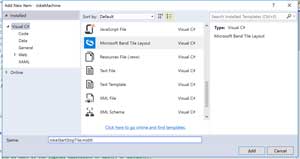 [Click on image for larger view.]
Figure 4. Adding Band Tile Layout
[Click on image for larger view.]
Figure 4. Adding Band Tile Layout
The newly created tile layout will be automatically opened, showing a design surface. From the Toolbox tool window I first need to select one of the Panels that will control the layout of the page. In this case I'm going to go with the Flow Panel (see Figure 5), which I can either drag and drop on the design surface, or I can simply double-click the item to add it.
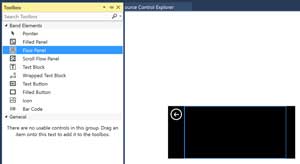 [Click on image for larger view.]
Figure 5. Tile Layout Designer
[Click on image for larger view.]
Figure 5. Tile Layout Designer
After adding the Flow Panel, which is similar to the XAML StackPanel in that it's going to present one item after another in a vertical (or horizontal) list, I add two Text Button and two Text Block elements, simply by double-clicking them in the Toolbox, resulting in a layout similar to Figure 6.
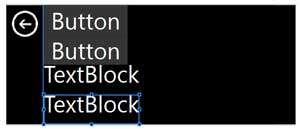 [Click on image for larger view.]
Figure 6. Tile Layout
[Click on image for larger view.]
Figure 6. Tile Layout
Once added to the layout, I need to go through each one, select it (by tapping on it on the design surface), and adjust one or more of its properties via the Properties tool window, as per the following list:
1st Button
ElementId: 2
Text: "Start"
2nd Button
Text: "Stop"
1st TextBlock
Text: "Status:"
2nd TextBlock
Text: ""
Name: "txtStatus"
Next, I'll go through how you can leverage this tile layout in the application. I'll start by adding in a class, shown in Listing 1, which will contain some string literals that will be used in a couple of places in the application. I'll be using a Windows Runtime (WinRT) Component later that has some restrictions on exposing public constant values, which is why the string literals have been defined as static properties instead of const.
Listing 1: JokeConstants Class
public static class JokeConstants
{
public static string TileId { get; } = "962A2F11-38F7-4091-AD13-76CE151FF442";
public static string PageId { get; } = "65432F5E-3E9B-4711-998E-BB868660B325";
public static string JokeTitle { get; } = "Band Joke";
public static string[] Jokes { get; } = {
"There was once a trumpet player who practiced 5 hours daily and was very conceited.",
"He liked to toot his horn.",
"What do you call 50,000 piccolos at the bottom of the sea? A good start.",
"What do you call a euphonist that isn't in a military band? Unemployed.",
"Johnny told his mom he wanted to play trumpet when he grew up. His mom said:
\"Honey, you can't do both, pick one.\"",
"How do you stop a guitarist? Sheet music."
};
}
In the code behind the MainPage, I'm going to override the OnNavigatedTo method in order to call the SetupBandTile method (shown in Listing 2) when the page is displayed. The code for the SetupBandTile method acquires a reference to the first paired Band, and subsequently opens a connection to the Band so that it can query and, if necessary, add the tile for the application.
Listing 2: SetupBandTile Method
private Guid TileId => new Guid(JokeConstants.TileId);
private Guid PageId => new Guid(JokeConstants.PageId);
protected async override void OnNavigatedTo(NavigationEventArgs e)
{
base.OnNavigatedTo(e);
await SetupBandTile();
}
public async Task SetupBandTile()
{
var pairedBands = await BandClientManager.Instance.GetBandsAsync();
using (var client = await BandClientManager.Instance.ConnectAsync(pairedBands[0]))
{
var existing = await client.TileManager.GetTilesAsync();
var myTile = existing.FirstOrDefault(x => x.TileId == TileId);
if (myTile == null && await client.TileManager.GetRemainingTileCapacityAsync() > 0)
{
var designed = new JokeStartStopTile();
myTile = new BandTile(TileId)
{
Name = "Jokes",
TileIcon = await LoadIcon("ms-appx:///Assets/LargeIcon.png"),
SmallIcon = await LoadIcon("ms-appx:///Assets/SmallIcon.png")
};
myTile.PageLayouts.Add(designed.Layout);
await designed.LoadIconsAsync(myTile);
await client.TileManager.AddTileAsync(myTile);
await client.TileManager.SetPagesAsync (TileId, new PageData(PageId, 0, designed.Data.All));
}
}
}
private async Task<BandIcon> LoadIcon(string uri)
{
var imageFile = await StorageFile.GetFileFromApplicationUriAsync(new Uri(uri));
using (var fileStream = await imageFile.OpenAsync(FileAccessMode.Read))
{
var bitmap = new WriteableBitmap(1, 1);
await bitmap.SetSourceAsync(fileStream);
return bitmap.ToBandIcon();
}
}
For brevity, and to highlight the steps involved in creating a tile on the Band, this code doesn't have any error handling. Particularly for code that establishes a wireless connection to a remote device, it's essential that sufficient exception handling is added to assist the user with diagnosing what's wrong. For example, if the application isn't able to find or connect to a Band, the application can present a notice to the user to ask them to ensure their Band is correctly paired to the device.
Before running the application I need to add the Bluetooth capability to the Package.appxmanifest file, shown in Figure 7. This permits the application to access the Bluetooth capability on the device.
 [Click on image for larger view.]
Figure 7. Adding Bluetooth Capability
[Click on image for larger view.]
Figure 7. Adding Bluetooth Capability
The code for setting up the tile actually relies on two images that aren't currently included in the project: LargeIcon and SmallIcon. These icons should be 46x46 and 24x24, respectively, and both should be white on a transparent background.
Now I can run the application and test to make sure the tile gets created. The first time I run the application I'll see two permission requests: The first one allows access to the Band; the second permits creation of a new tile. After agreeing to these permission requests, the Band will temporarily go into an "Updating" state where the interface is blocked while the new tile is created.
Currently, all I've done is create a static tile on the Band, based on the tile layout I created earlier. The core functionality of this application is to periodically display a joke to the user. For this, I'll need a background task that will execute periodically in order to send a notification to the Band.
In order to create the background task, I first need to add a new WinRT Component to the solution via the Add New Project dialog (Figure 8).
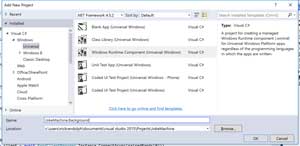 [Click on image for larger view.]
Figure 8. Adding Windows Runtime Component
[Click on image for larger view.]
Figure 8. Adding Windows Runtime Component
I need to add a reference to the new JokesMachine.Background project, to the JokeMachine application. This can be done by right-clicking on the JokeMachine project and selecting Add Reference. From the Add Reference dialog, make sure that there is a check against the JokesMachine.Background project within the Solution tab.
As the string literals defined in the JokesConstants class need to be accessible in both the JokeMachine application and the background task, I'm going to move the JokesConstants class into the JokeMachine.Background project. In doing this, I need to amend the namespace of the JokesConstants class to JokeMachine.Background, and update the appropriate in-code references to this class within the JokeMachine project.
The background task implementation is simply a class that implements the IBackgroundTask interface. I'll rename the default Class1.cs file that was created with the project to Jokes.cs. In doing this, I get prompted by Visual Studio to change the corresponding class name to Jokes.
Before I complete the background task implementation, there are a couple of other configuration steps that are required. I need to add a reference to the Microsoft.Band NuGet Package -- this is done by revisiting the NuGet package manager and adding the NuGet package to the new background task project.
It's necessary for the background task to be registered in the package.appxmanifest file (see Figure 9).
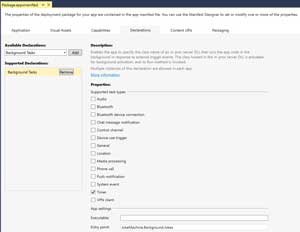 [Click on image for larger view.]
Figure 9. Register Background Task
[Click on image for larger view.]
Figure 9. Register Background Task
It's also necessary for background tasks to be registered by the application. I'll do this before setting up the tile in the OnNavigatedTo method:
protected async override void OnNavigatedTo(NavigationEventArgs e) { base.OnNavigatedTo(e); await RegisterBackgroundTask(typeof(JokeMachine.Background.Jokes).FullName,
"Jokes", new TimeTrigger(15, false), null); await SetupBandTile(); }
This calls into the RegisterBackgroundTask method (Listing 3), which will attempt to locate any existing background tasks, and only register the new background task if it doesn't already exist. The important thing to note is that the RegisterBackgroundTask method accepts a trigger parameter, which in this case is a TimeTrigger set to a recurring period of 15 minutes.
Listing 3: RegisterBackgroundTask Method
public static async Task<IBackgroundTaskRegistration> RegisterBackgroundTask(
string taskEntryPoint,
string taskName,
IBackgroundTrigger trigger,
IBackgroundCondition condition)
{
var status = await BackgroundExecutionManager.RequestAccessAsync();
if (status == BackgroundAccessStatus.Denied || status ==
BackgroundAccessStatus.Unspecified) return null;
var current = (from t in BackgroundTaskRegistration.AllTasks
where t.Value.Name == taskName
select t.Value).FirstOrDefault();
if (current != null) return current;
var builder = new BackgroundTaskBuilder
{
Name = taskName,
TaskEntryPoint = taskEntryPoint
};
builder.SetTrigger(trigger);
if (condition != null)
{
builder.AddCondition(condition);
}
return builder.Register();
}
The implementation of the background task is going to select a joke from the list of predefined jokes in the JokeConstants class. In the Jokes implementation in Listing 4, the Run method (required in order to implement the IBackgroundTask interface) acquires a deferral before calling the TellAJoke method. The deferral will ensure that the background task doesn't terminate until the TellAJoke method has been completed.
Listing 4: Implementing JokesConstant Class via iBackgroundTask
public sealed class Jokes : IBackgroundTask
{
private Guid TileId => new Guid(JokeConstants.TileId);
private Guid PageId => new Guid(JokeConstants.PageId);
private const string JokeIndexKey = "Index";
private const string IsRunningKey = "Running";
private static IBandClient BandClient { get; set; }
private BackgroundTaskDeferral BackgroundTaskDeferral { get; set; }
private bool IsRunning =>
(bool)(ApplicationData.Current.LocalSettings.Values[IsRunningKey] ?? false);
public void Run(IBackgroundTaskInstance taskInstance)
{
BackgroundTaskDeferral = taskInstance.GetDeferral();
// Associate a cancellation handler with the background task.
taskInstance.Canceled += OnTaskCanceled;
TellAJoke();
}
private void TellAJoke()
{
// Select the joke to tell
var index = (int)(ApplicationData.Current.LocalSettings.Values[JokeIndexKey] ?? 0) %
JokeConstants.Jokes.Length;
var joke = JokeConstants.Jokes[index++];
ApplicationData.Current.LocalSettings.Values[JokeIndexKey] = index;
ConnectBand(false);
// Remove previous jokes
BandClient.TileManager.RemovePagesAsync(TileId);
// Send a joke.
BandClient.NotificationManager.SendMessageAsync(TileId, JokeConstants.JokeTitle, joke,
DateTimeOffset.Now, MessageFlags.ShowDialog).Wait();
CompleteTask();
}
private void ConnectBand(bool inBackground = true)
{
if (BandClient == null)
{
var pairedBands = BandClientManager.Instance.GetBandsAsync(inBackground).Result;
if (pairedBands?.Length > 0)
{
BandClient = BandClientManager.Instance.ConnectAsync(pairedBands[0]).Result;
}
}
}
private void OnTaskCanceled(IBackgroundTaskInstance sender,
BackgroundTaskCancellationReason reason)
{
CompleteTask();
}
private void CompleteTask()
{
DisconnectBand();
// Complete the service deferral.
BackgroundTaskDeferral?.Complete();
}
private void DisconnectBand()
{
BandClient?.Dispose();
BandClient = null;
}
}
As you see from this code, there isn't much involved in the TellAJoke method. However, there are a number of supporting methods to connect and disconnect from the Band. It's important that you clean up any connections to the Band to prevent any locking issues with other applications or tasks attempting to access the Band.
With the background task implemented, it's time to run the application and test out the ability for the application to tell a joke. Rather than having to wait for 15 minutes in the hope that the Band comes to life, Visual Studio actually allows developers to trigger a background task from the Debug Location toolbar. If you don't have this toolbar visible, you might need to select it by right-clicking in any free space on the Visual Studio toolbar are (see Figure 10).
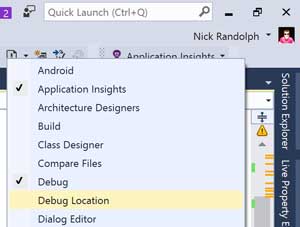 [Click on image for larger view.]
Figure 10. Opening Debug Location Toolbar
[Click on image for larger view.]
Figure 10. Opening Debug Location Toolbar
The Lifecycle Events dropdown lets me select the background task that I want to invoke, as shown in Figure 11.
 [Click on image for larger view.]
Figure 11. Running Background Task
[Click on image for larger view.]
Figure 11. Running Background Task
The last phase of this application is to wire up event handlers for the Start and Stop buttons on the tile so that the user can start and stop the generation of jokes. Note that these buttons won't start or stop the actual periodic background task, as this isn't possible from within the background task itself.
In addition to responding to the buttons on the page of the tile, the background task will also present feedback to the user by updating the data presented on the tile. For this, I'll reuse the JokeStartStopTile layout I created earlier, by copying it into the WinRT Component project.
When a user clicks on a tile, or a button on a page, the Windows application can respond to the event by exposing an App Service. The App Service will be invoked by the Microsoft Health application but needs my application to register the background task as an App Service; this is shown in Figure 12. Note that while the Entrypoint only has to correlate to the background task class name, the Name has to be set to the static value com.microsoft.band.observer.
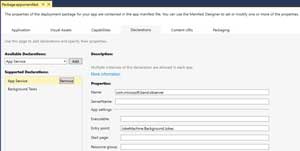 [Click on image for larger view.]
Figure 12. Registering App Service
[Click on image for larger view.]
Figure 12. Registering App Service
In the Jokes class, I need to add a reference to an AppServiceConnection object:
private AppServiceConnection AppServiceconnection { get; set; }
Next, in the Run method, I need to replace the call to TellAJoke with the code in Listing 5.
Listing 5: Replacement Code for Call to TellAJoke
// Add our handlers for tile events
BackgroundTileEventHandler.Instance.TileOpened += EventHandler_TileOpened;
BackgroundTileEventHandler.Instance.TileClosed += EventHandler_TileClosed;
BackgroundTileEventHandler.Instance.TileButtonPressed += EventHandler_TileButtonPressed;
// Retrieve the app service connection and set up a listener for incoming app service requests.
var details = taskInstance.TriggerDetails as AppServiceTriggerDetails;
if (details != null)
{
AppServiceconnection = details.AppServiceConnection;
AppServiceconnection.RequestReceived += OnRequestReceived;
}
else
{
TellAJoke();
}
This code defines a number of event handlers for tile event such as Opened, Closed and ButtonPressed. When the tile is opened, the status on the page will be updated; when the buttons are pressed, depending on which one is pressed, the IsRunning property value will be toggled. These methods are defined in Listing 6.
Listing 6: Opened, Closed and ButtonPressed Methods
private async void OnRequestReceived(AppServiceConnection sender, AppServiceRequestReceivedEventArgs args)
{
// Get a deferral because we use an awaitable API below to respond to the message
// and we don't want this call to get cancelled while we are waiting.
var messageDeferral = args.GetDeferral();
var responseMessage = new ValueSet();
// Decode the received message and call the appropriate event handler
BackgroundTileEventHandler.Instance.HandleTileEvent(args.Request.Message);
// Send the response message
await args.Request.SendResponseAsync(responseMessage);
// Complete the deferral so that the platform knows that we're done responding
messageDeferral.Complete();
}
private void EventHandler_TileOpened(object sender, BandTileEventArgs<IBandTileOpenedEvent> e)
{
UpdatePageData($"Welcome to the Joke Machine {IsRunning}");
}
private void EventHandler_TileClosed(object sender, BandTileEventArgs<IBandTileClosedEvent> e)
{
DisconnectBand();
}
private void EventHandler_TileButtonPressed(object sender, BandTileEventArgs<IBandTileButtonPressedEvent> e)
{
var running = e?.TileEvent?.ElementId == 2;
ApplicationData.Current.LocalSettings.Values[IsRunningKey] = running;
UpdatePageData(running ? "Joke Machine is Running!" : "Joke Machine Stopped");
}
private void UpdatePageData(string status)
{
ConnectBand();
var designed = new JokeStartStopTile();
designed.Data.BeginModify();
designed.txtStatusData.Text = status;
BandClient.TileManager.SetPagesAsync(TileId,
new PageData(PageId, 0, designed.Data.All)).Wait();
}
It's worth noting that the ElementId of the buttons is defined in the JokeStartStopTile layout that was created earlier. This code looks to see if it was the Start button (that is, the button with ElementId of 2) to decide if the joke machine should be enabled. Of course, we also need to update the TellAJoke method to exit if IsRunning is set to false. I just need to add the following line to the beginning of the TellAJoke method:
if (!IsRunning) return;
There's one final piece that's required in order for tile events on the Band to be correctly routed through to the background task of the application. This is to call the SubscribeToBackgroundTileEventsAsync method on the Band client object, providing the Id of the tile that the application is subscribing to events for:
// Subscribe to background tile events
await client.SubscribeToBackgroundTileEventsAsync(TileId);
This brings together the final piece of this application, allowing for the joke machine to be disabled by the user by tapping on the appropriate button on the page of the tile.
In this article I've walked through a simple example that creates and updates a tile, as well as intercepting tile events whilst the application is in the background. This is only the beginning of the use cases that can be achieved by combining a smartphone and the Band.